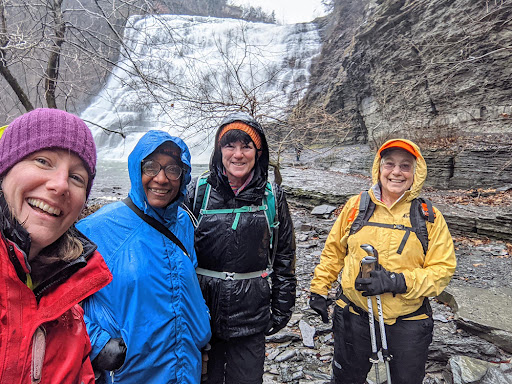Winter in Upstate New York turns the region into a stunning winter wonderland. Snow-covered mountains, frozen waterfalls, and crystal-clear views await those who venture into the cold. However, winter hiking is much more challenging than hiking in warmer months. The cold temperatures demand extra preparation and attention to detail. If you’re new to winter hiking, this guide will help you stay safe and enjoy the adventure.
Plan Around Daylight
Winter days are much shorter, so planning your hike around daylight is crucial. Always check local sunrise and sunset times before heading out. Due to the snow and ice, hiking in winter takes longer than in warmer months. A hike that would take three hours in the summer may take four or five hours in winter. The extra gear, slower pace, and frequent stops to adjust layers or warm up all contribute to the longer duration.
To ensure safety, finish your hike before it gets dark. Even on shorter hikes, always carry a headlamp with fresh batteries, and it’s a good idea to carry two. Before setting out, let someone know your plans, including your route and expected return time. Provide details about your car’s make, model, license plate number, and the trailhead where you’re parking.
Layer Up for Safety
Proper clothing is key to staying warm and comfortable while hiking in winter. Layering your clothes is essential to regulate your body temperature. Here’s how to layer effectively for winter hikes:
- Base Layer: Choose synthetic or merino wool materials. These fabrics help wick moisture away from your skin, keeping you dry and warm.
- Insulating Layer: Fleece or wool is perfect for trapping heat and providing warmth.
- Shell Layer: A waterproof and windproof outer layer will protect you from the elements.
Avoid wearing cotton, as it absorbs moisture and stays cold, increasing the risk of hypothermia. Always bring extra layers, including socks, gloves, and a dry base layer. Pay extra attention to your extremities, such as fingers, toes, ears, and nose, as they are most vulnerable to frostbite.
If you’re feeling warm, remove layers before you start sweating. If you’re getting cold, add layers before you start shivering. Regularly adjust your clothing during short breaks. Long breaks in cold weather can quickly lead to hypothermia.
Essential Winter Gear
In addition to standard hiking gear, winter hiking requires some extra equipment to keep you safe and comfortable. Here’s a list of essential gear for winter hiking:
- Traction Devices (Microspikes): These are necessary for walking on ice and packed snow.
- Waterproof Boots: Choose boots that are rated for cold temperatures and waterproof to keep your feet dry.
- Gaiters: These are worn over your boots to keep snow from getting inside.
- Insulated Water Bottles: These prevent your water from freezing.
- Extra Food: Carry extra food to keep your energy levels up.
- Emergency Shelter: A space blanket is a lightweight option for emergency shelter.
- First Aid Kit: Include hand and toe warmers for added comfort.
- Winter Hat, Neck Gaiter, and Waterproof Gloves: These protect your head, neck, and hands from the cold.
- Map and Compass: Don’t rely solely on your phone. Always carry a map and compass in case of emergencies.
If snow depth exceeds 6-8 inches, snowshoes become necessary. Learn when to switch from microspikes to snowshoes to avoid damaging trails and exhausting yourself by stepping through deep snow.
Managing Your Body Temperature
One of the biggest challenges of winter hiking is managing your body temperature. Hiking uphill can make you sweat, but stopping can make you cold. Moisture is your enemy in winter, so managing sweat is crucial.
Start your hike feeling slightly chilly. During breaks, find sheltered spots away from the wind. If needed, change into dry base layers, especially after a strenuous uphill climb. Always keep an eye on your hiking partners for signs of trouble, such as shivering, confusion, slurred speech, or unusual fatigue. These could be signs of hypothermia. Pale or waxy skin, especially on the face, fingers, or toes, could indicate frostbite.
Food and Water Are More Critical Than Ever
In cold weather, your body burns more calories to stay warm. Pack calorie-dense foods that won’t freeze, such as nuts, chocolate, hard cheese, jerky, and dense granola bars. Bring a thermos with hot soup or tea to keep your spirits high and raise your core temperature.
Water management is also crucial. Water bottles freeze from the top down, but you can carry them upside down in your pack to slow freezing. Wide-mouth bottles freeze more slowly than narrow ones. If you use a hydration bladder, blow back into the tube after each drink to clear it of water. Keep your food and water easily accessible so you don’t waste time digging through your pack.
Weather is the Most Important Factor
Always check the weather forecast before heading out, including wind chill and precipitation. Mountain weather can change rapidly, and temperatures drop as you gain elevation. Expect more severe conditions on exposed summits. Strong winds can create dangerous wind chills and cause disorientation in open areas. Ice and deep snow can make familiar trails unrecognizable.
Know When to Turn Back
Winter hiking requires good judgment, and knowing when to turn back is one of the most important decisions you’ll make. Set a firm turnaround time and stick to it, regardless of how close you are to your goal. If the weather worsens, visibility drops, or someone feels unwell, turn back immediately. Getting your group home safely is more important than reaching the summit.
Enjoying Winter Hiking in Upstate New York
Winter hiking in Upstate New York offers stunning views and the satisfaction of exploring winter landscapes. However, it requires preparation, the right gear, and good decision-making. Start with shorter hikes on familiar trails and gradually build your experience. The rewards of a winter hike—snow-covered peaks, clear winter views, and the thrill of hiking in a winter wonderland—make the extra effort worth it.
Disclaimer: Our editorial team has thoroughly fact-checked this article to ensure its accuracy and eliminate any potential misinformation. We are dedicated to upholding the highest standards of integrity in our content.





More Stories
Winter Hiking Safety and Preparation Tips for Newcomers to Upstate New York Trails
Winter Hiking Safety and Preparation Tips for Newcomers to Upstate New York Trails
Winter Hiking Safety and Preparation Tips for Newcomers to Upstate New York Trails